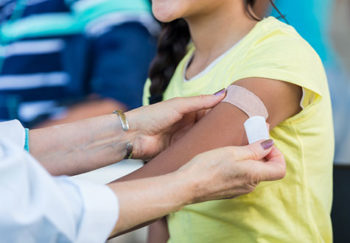
As I wrote yesterday, there’s no shortage of information and misinformation about vaccines on the internet. One myth, about the benefits of delayed vaccine schedules, deserved its own post.
There is only one CDC-approved vaccination schedule, but some parents opt to spread vaccines out a bit more. So, why is the recommended schedule the way it is, and does it ever make sense to use delayed vaccine schedules?
The Science Behind the Recommended Vaccine Schedule
The recommended vaccine schedule is based on two things:
1.) When children are likely to be exposed to these infections
2.) When their immune systems are developed enough to safely respond to the vaccine
What Interests Parents About Alternative Vaccine Schedules?
According to John Gazewood, MD, parents get worried about all the shots.
“We try to urge the parents to go ahead and get them done. Many vaccinations have been combined over the years, so with some of these vaccines, we’re able to vaccinate against several diseases with just a single injection, cutting down on the number of shots,” Gazewood explains.
Behind on Vaccines?
Find a pediatrician or family physician to help you catch up.
Getting them done on the recommended schedule ensures the child is as protected as possible, and it also means fewer visits for shots in the long run. Plus, according to Gazewood, a child isn’t likely to be any fussier after multiple shots compared to just one.
As we discussed in the Vaccine Myths and Facts post yesterday, the myth that too many vaccines at once can overload a child’s immune system is just that – a myth.
The Risks and Benefits of Delayed Vaccine Schedules
The biggest risk is not protecting a child against a disease they could be exposed to. Another risk: There aren’t any “alternative” vaccination schedules that have been approved for safety and effectiveness.
“If a child comes in for vaccines and they have a high fever, we will not give them the vaccines that day, but other than that, there isn’t a clinical reason to delay a vaccine,” says Gazewood. There are occasionally medical exemptions for children and adults who have compromised immune systems or an allergy to the vaccine. But, for people with healthy immune systems, there isn’t a clinical reason not to follow the recommended schedule.
Check out this infographic for the CDC’s recommended vaccines by age:

Infographic text: Recommended Vaccine Schedule
From newborns to school-age adolescents, vaccines are the best way to prevent potentially harmful diseases that can be serious or deadly.
- Newborn (up to 12 months)
- Hep B*
- DTaP*
- Hib*
- Polio*
- Pneumococcal*
- Rotavirus*
- Influenza
- *With multiple boosters throughout the year
- Toddler (1 – 3 years)
- Chickenpox
- DTaP
- Hib
- MMR
- Polio
- Pneumococcal
- Influenza*
- Hep A
- Hep B
- *Recommended flu vaccine every year
- Grade K – 5 (4 – 10 years)
- DTaP
- Polio
- MMR
- Chickenpox
- Influenza*
- *Recommended flu vaccine every year
- Grade 6- 8 (11 – 14 years)
- Meningococcal
- HPV
- Tdap
- Influenza*
- *Recommended flu vaccine every year
- Routine Maintenance (15+ years)
- Influenza: recommended annually
- Tdap: recommended every 10 years
- MMR: possible 2nd dose to ensure total of two doses
- Varicella: possible 2nd dose to ensure total of two doses
- HPV: recommended 2 or 3 doses depending on age at initial vaccine
- Meningococcal: recommended 2nd vaccine at age 16
Vaccine Definitions
- DTaP (abbreviation)
- Diphtheria, a disease caused by bacteria causing inflammation of the heart and nervous system
- Tetanus, fatal disease caused by a bacteria that enters the body through a wound
- Whooping cough, an infectious respiratory disease which can be fatal, especially in infants
- Hep A (noun)
- Hepatitis A, a virus transmitted in food and water contaminated with infected fecal matter
- Hep B (noun)
- Hepatitis B, a virus transmitted by contact with infected blood or bodily fluids which can lead to liver failure or cirrhosis
- Hib (noun)
- Haemophilus influenza type B, bacteria that cause meningitis and pneumonia especially in children
- HPV (abbreviation)
- Human papilloma virus, a virus that ca cause genital warts and possibility of cervical cancer
- MMR (abbreviation)
- Measles, a highly contagious disease with fever and widespread red rash, which can cause pneumonia and infection of the brain and can be fatal
- Mumps, a contagious virus that causes fever and gland swelling, it can infect the brain and can cause infertility in men
- Rubella, a viral infection with a fever, sore throat and rash, can cause serve birth defects if a pregnant woman becomes infected
- Tdap (abbreviation)
- Tetanus, fatal disease caused by a bacteria that enters the body through a wound
- Diphtheria, a disease caused by bacteria causing inflammation of the heart and nervous system
- Pertussis (whooping cough), an infectious respiratory disease
- Varicella (noun)
- Chickenpox, a contagious disease mainly in children with a fever and rash caused by a strain of herpesvirus


For an article with such a conclusive title I was hoping to find a bit more scientific research backing it up. I am kind of disappointed because it is yet another article with statements and references what the “authoritative” bodies have concluded. Unfortunately we live in a world where these authoritative bodies have accumulated a history of stating things like DDT is perfectly safe. While I wish I could simplify life by trusting such authorities, that trust has been broken so I would like an article that takes a look into what concerns were tested. Fact is that we live in a world where allergies are becoming common, and since science does not have a clear idea what is causing them, something “safe” may be the cause.